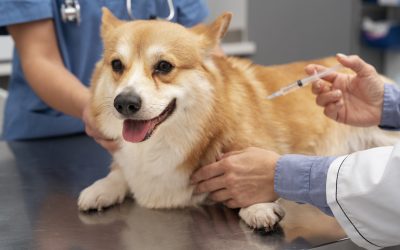Dog Ear Canal Surgery: When it’s Necessary & What it Costs

Updated October 12, 2025
Total Ear Canal Ablation (TECA) surgery is performed on dogs to treat chronic ear infections or other conditions affecting the ear canal. It involves completely removing the affected ear canal, including the eardrum and surrounding tissues. TECA surgery is usually recommended when other treatment options have failed or when the dog experiences recurrent ear infections that cause significant pain and discomfort.
During the surgery, the veterinarian will make an incision behind the affected ear and carefully remove the entire ear canal. This procedure eliminates the source of infection and provides long-term relief for the dog. After the surgery, the dog’s ear will typically be left open to allow for proper drainage and healing.
Signs of Hematoma in Dogs
Hematomas are a common condition in dogs that can occur in the ear flaps as a result of trauma or vigorous shaking of the head. A hematoma is a pocket of blood that forms between the layers of tissue in the ear flap, causing swelling and discomfort. Some of the signs of a hematoma in dogs include:
Swelling: The affected ear flap may appear swollen and feel warm to the touch.
Pain: Dogs with hematomas may exhibit signs of pain, such as shaking their heads or pawing at their ears.
Fluctuation: When gently palpated, the hematoma may feel like a fluid-filled sac that moves or fluctuates.
Deformed Ear Flap: As the hematoma progresses, the ear flap may become misshapen or wrinkled.
If you suspect that your dog has a hematoma, consult with a veterinarian for a proper diagnosis and treatment plan.
Diagnosis of Hematoma in Dogs
A veterinarian will physically examine the affected ear flap in dogs to diagnose a hematoma. They will carefully palpate the area and look for swelling or fluid accumulation. Sometimes, the veterinarian may use a needle and syringe to aspirate fluid from the hematoma for further examination.
Additionally, the veterinarian may recommend further diagnostic tests, such as blood work or imaging studies, to rule out underlying causes or complications. These tests can help determine the dog’s overall health and guide the treatment plan.
If you suspect your dog has a hematoma, you must seek veterinary care promptly. Early diagnosis and treatment can help prevent further complications and discomfort for your furry friend.
Cost of Ear Canal Ablation Surgery for Dogs
The cost of ear canal ablation surgery for dogs can vary depending on various factors, including the dog’s size, the severity of the condition, and the location of the veterinary clinic. On average, the cost of TECA surgery can range from $3,500 to $4,400.
It is important to note that the cost of the surgery may also include pre-operative examinations, anesthesia, medications, and post-operative care. Each veterinary clinic may have its own pricing structure, so it is advisable to consult with your veterinarian for an accurate estimate.
While the cost of the surgery may seem significant, it is essential to consider the long-term benefits and improved quality of life that ear canal ablation surgery can provide for your dog. Investing in their health and well-being is a worthwhile decision.
Factors Influencing the Cost of Ear Canal Surgery
Several factors can influence the cost of ear canal surgery for dogs. These factors include:
Geographic Location: The cost of veterinary services can vary depending on the region or city where the clinic is located. Urban areas tend to have higher prices than rural areas.
Clinic Reputation: Well-established clinics with experienced veterinarians may charge higher service fees.
Dog’s Size: Larger dogs may require more extensive surgery, anesthesia, and post-operative care, resulting in higher costs.
Severity of the Condition: The extent of the ear canal infection or other underlying conditions can affect the complexity of the surgery and subsequently impact the cost.
Additional Services: The cost of the surgery may include pre-operative examinations, medications, anesthesia, and post-operative care.
You should discuss the estimated cost and the breakdown of expenses with your veterinarian before proceeding with the surgery. This will help you understand the financial commitment involved and make an informed decision.
Inclusions in the Cost of Ear Canal Surgery for Dogs
When considering the cost of ear canal surgery for dogs, it is crucial to understand what is typically included in the overall price. Some of the common inclusions in the cost of TECA surgery may consist of:
Pre-operative Examinations: Your veterinarian will conduct thorough examinations to assess the dog’s overall health and identify any underlying conditions that may impact the surgery.
Anesthesia: The cost of anesthesia is typically included in the overall surgical fee. This ensures that the dog remains comfortable and pain-free during the procedure.
Surgical Procedure: The cost covers the surgical procedure itself, including the removal of the affected ear canal and any necessary additional treatments.
Medications: Post-operative medications, such as pain relievers and antibiotics, are often included in the cost to aid in the dog’s recovery.
Post-operative Care: The cost typically includes follow-up visits and post-operative care to monitor the dog’s healing progress and address any concerns or complications.
It is important to clarify with your veterinarian the specific inclusions in the cost of ear canal surgery for your dog. This will help you plan and budget accordingly.
Exclusions from the Cost of Ear Hematoma Surgery for Dogs
While the cost of ear hematoma surgery for dogs may include several aspects of the procedure and post-operative care, there are some exclusions that pet owners should be aware of. These exclusions may include:
Pre-operative Diagnostic Tests: Additional diagnostic tests, such as blood work or imaging studies, may be necessary to assess the dog’s overall health and rule out underlying conditions. These tests are typically not included in the surgical cost.
Aftercare Supplies: Items such as e-collars, bandages, or wound care products may be required for the dog’s post-operative care. These supplies are usually not included in the overall cost and may need to be purchased separately.
Complications or Additional Treatments: In some cases, complications may arise during or after the surgery, requiring additional treatments or procedures. These additional costs are typically not included in the initial surgical estimate.
Preventing Ear Hematoma in Dogs
While ear hematomas can occur in dogs for various reasons, there are some preventive measures that pet owners can take to reduce the risk. Regular ear cleaning is essential to maintain good ear hygiene and prevent the buildup of wax and debris. Additionally, avoiding activities that can cause trauma or vigorous shaking of the head can help minimize the risk of hematoma formation.
Suppose your dog is prone to ear infections or has a history of ear problems. In that case, working closely with your veterinarian to develop an appropriate preventive care plan is essential. This may include routine ear cleaning, regular check-ups, and the use of ear medications or cleaners as recommended.
By being proactive in your dog’s ear care and monitoring their overall health, you can help minimize the likelihood of ear hematomas and other ear-related issues.
The Necessity of Ear Canal Surgery for Dogs with the Condition
Ear canal surgery, such as total ear canal ablation, is typically recommended for dogs with severe and chronic ear infections that do not respond to other treatment options. Chronic ear infections can cause significant pain and discomfort for dogs, leading to a decreased quality of life.
Surgery becomes necessary when other treatments, such as medications or cleaning, fail to alleviate the symptoms and resolve the infection. Ear canal surgery aims to remove the source of infection and provide long-term relief for the dog.
It is important to consult with your veterinarian to determine whether ear canal surgery is necessary for your dog. The veterinarian will assess the severity of the condition, consider the dog’s overall health, and discuss the potential benefits and risks of the surgery.
Recovery Process for Dogs After Ear Hematoma Surgery
The recovery process for dogs after ear hematoma surgery can vary depending on the individual dog and the extent of the surgery. After the procedure, your dog may require a few days of hospitalization for close monitoring and proper wound care.
During the recovery period, following your veterinarian’s instructions is essential to ensure a smooth and successful healing process. This may include administering medications, keeping the surgical site clean and dry, and preventing your dog from scratching or rubbing their ears.
Your veterinarian will schedule follow-up appointments to assess the dog’s progress and remove any necessary sutures. Attending these appointments and communicating any concerns or changes in your dog’s condition is important.
Most dogs recover well after ear hematoma surgery with proper post-operative care and patience. They can resume their normal activities and enjoy a better quality of life without the discomfort and pain caused by the hematoma.
How Can Pet Insurance Help You?
Pet insurance can be a valuable tool in managing the costs of treating dog canal surgery and other veterinary expenses. By having a pet insurance policy in place, you can have peace of mind knowing that you can provide medical care for your furry companion without worrying about the financial burden. Pet insurance can help cover the costs of veterinary consultations, diagnostic tests, medications, and even specialized treatments if required.
Reimbursement
This method is the most common for pet insurance companies. You pay out of pocket for the veterinarian bill, and then the insurance company reimburses you for what’s covered under the insurance plan. The steps look like this.
- You pay the vet bill after your dog’s visit.
- You fill out the pet insurance claim form.
- Submit the claim form and other required documentation to the insurer.
- After the claim is approved, you will be reimbursed for eligible expenses.
What Does Odie Pet Insurance Cover?
Pet insurance covers various veterinary expenses, providing financial protection and peace of mind for pet owners. Here are the details of the coverage options offered by Odie Pet Insurance:
Illness & Injury Plan
The Illness & Injury Plan is an all-inclusive insurance plan designed to cover a wide range of medical needs for your pet. This plan includes comprehensive coverage for various illnesses, injuries, and veterinary services. Some of the covered items include:
- Veterinary exams and consultations
- Diagnostics (e.g., X-rays, lab tests)
- Prescribed medications
- Surgeries and hospitalization
- Rehabilitation, acupuncture, or chiropractic treatments
- Medically necessary supplies
- Euthanasia and cremation
The Wellness Plan
The Wellness Plan is a monthly membership that focuses on preventive care and covers routine veterinary services.
- Provides reimbursements for routine care items such as wellness visits (exams and vaccines), testing and parasite prevention, dental cleanings and at-home dental care, vitamins, supplements, and more
- Through Odie’s partnership with Petivity, a leader in smart pet products and proactive care, Wellness Plan members can also receive reimbursements for Petivity devices and health kits, as well as eligible Purina food and supplements.
- Total reimbursement up to $700 per year.
Dog Ear Canal Surgery – FAQs
What is TECA surgery, and when is it necessary?
Total Ear Canal Ablation (TECA) removes the entire diseased ear canal (vertical and horizontal sections) and cleans the middle ear cavity. Necessary for severe chronic ear infections unresponsive to treatment, ruptured eardrums with middle ear infection (50% of chronic cases), ear canal cancer, congenital defects, or severe canal narrowing/mineralization from chronic inflammation.
How much does ear canal surgery cost?
TECA surgery typically costs $3,500-$4,400 per ear, including pre-op exams, anesthesia, surgery, medications, and post-op care. Costs vary by location (urban areas are higher), condition severity, whether one or both ears need surgery, surgeon experience, and dog size. Additional costs include diagnostics ($100-$500), hospitalization, and treatment of underlying conditions.
What does the surgery involve and what are the risks?
Performed under general anesthesia, the surgeon removes the diseased ear canal, opens the middle ear to remove infected tissue, and sutures the closure. Surgery is delicate due to the proximity of the facial nerve. Risks include facial nerve paralysis (5-10% of cases—higher with severe disease), infection, bleeding, anesthetic complications (rare), and cosmetic changes to ear appearance.
What is recovery like after TECA surgery?
Recovery takes 2-3 weeks for surgical site healing (3-6 weeks if an inner ear infection was present). Post-op care includes hospitalization on surgery day, bandage changes (up to a week if a drain is placed), drain injections with antiseptic, pain medications, antibiotics, follow-up visits for suture removal, and keeping the site clean/dry. Most dogs recover well and act “like a puppy again.”
Will my dog’s hearing be affected?
Yes, hearing will be lost in the operated ear since there’s no canal opening. However, most dogs with chronic ear disease already have significant hearing loss pre-surgery. Many still respond to sounds like doorbells. If both ears are operated on, hearing loss is more significant but dogs adapt well.
Does pet insurance cover TECA surgery?
Many policies cover medically necessary TECA if not pre-existing. Coverage varies—some cover first-time infections but may exclude chronic conditions. Waiting periods apply (often 6+ months for certain procedures). Alternatives: payment plans with vets, nonprofit financial assistance, CareCredit, or comparing prices at different clinics. Get insurance before conditions develop for the best coverage.




